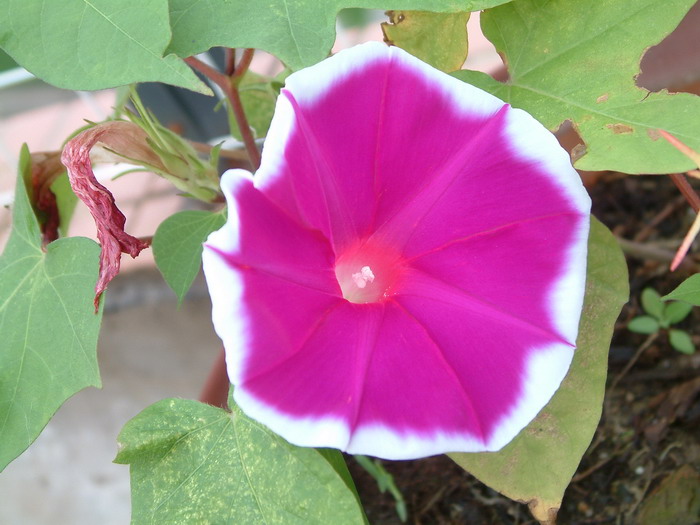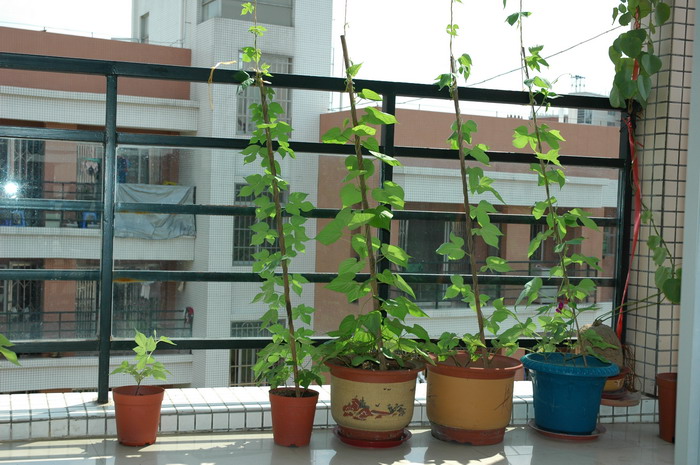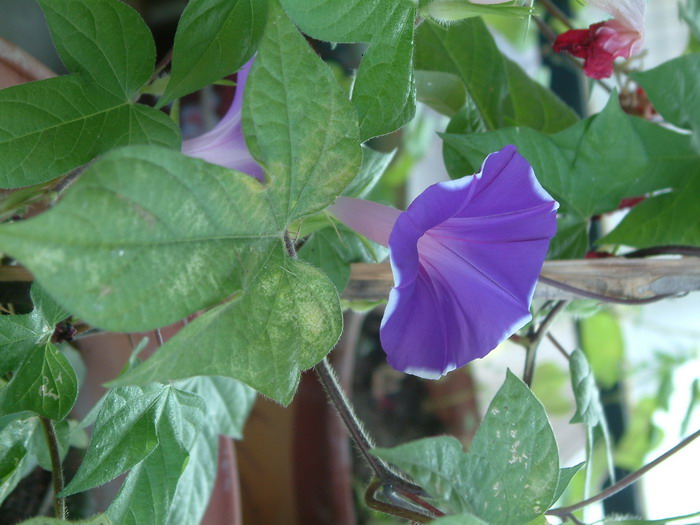牵牛Ipomoea nil
中文名(Chinese Name):牵牛
学名(Scientific Name): Ipomoea nil (L.) Roth
英文名(English Common Name):whiteedge morning-glory
别名(Chinese Common Name):喇叭花、勤娘子
异名(Synonym):Pharbitis nil (Linn.) Choisy Pharbitis hederacea (Linn.) Choisy Pharbitis limbata Lindl. Convolvulus nil L. Ipomoea vaniotiana H. Lév. Ipomoea trichocalyx Steud. Ipomoea scabra Forssk. Ipomoea nil var. setosa (Blume) Boerl. Convolvulus tomentosus Vell. Ipomoea longicuspis Meisn. Ipomoea cuspidata Ruiz & Pav. Pharbitis cuspidata (Ruiz & Pav.) G. Don Pharbitis githaginea Hochst.
科属(Family & Genus):旋花科(Convolvulaceae)番薯属
形态特征(Description):一年生缠绕草本,茎上被倒向的短柔毛及杂有倒向或开展的长硬毛。叶宽卵形或近圆形,深或浅的3裂,偶5裂,长4-15厘米,宽4.5-14厘米,基部圆,心形,中裂片长圆形或卵圆形,渐尖或骤尖,侧裂片较短,三角形,裂口锐或圆,叶面或疏或密被微硬的柔毛;叶柄长2-15厘米,毛被同茎。花腋生,单一或通常2朵着生于花序梗顶,花序梗长短不一,长1.5-18.5厘米,通常短于叶柄,有时较长,毛被同茎;苞片线形或叶状,被开展的微硬毛;花梗长2-7毫米;小苞片线形;萼片近等长,长2-2.5厘米,披针状线形,内面2片稍狭,外面被开展的刚毛,基部更密,有时也杂有短柔毛;花冠漏斗状,长5-8(-10)厘米,蓝紫色或紫红色,花冠管色淡;雄蕊及花柱内藏;雄蕊不等长;花丝基部被柔毛;子房无毛,柱头头状。蒴果近球形,直径0.8-1.3厘米,3瓣裂。种子卵状三棱形,长约6毫米,黑褐色或米黄色,被褐色短绒毛。
分布(Distribution):我国除西北和东北的一些省外,大部分地区都有分布,生于海拔100-1600米的山坡灌丛、干燥河谷路边、宅旁等。原产热带美洲。
用途(Use):
引自中国植物志英文版FOC Vol. 16 Page 305
Ipomoea nil (Linnaeus) Roth, Catal. Bot. 1: 36. 1797.
牵牛 qian niu | Convolvulaceae | Ipomoea
Convolvulus nil Linnaeus, Sp. Pl. ed. 2. 1: 219. 1762; C. hederaceus Linnaeus; Ipomoea hederacea (Linnaeus) Jacquin; I. nil var. setosa (Blume) Boerlage; I. scabra Forsskål; I. setosa Blume; I. trichocalyx Steudel; I. vaniotiana H. Léveillé; Pharbitis nil (Linnaeus) Choisy.
Herbs annual, twining, with retrorsely hirsute axial parts. Stems 2-5 m. Petiole 2-15 cm; leaf blade broadly ovate or nearly circular, 4-15 X 4.5-14 cm, hirtellous, base cordate, margin entire or ± 3- (or 5)-lobed, apex acuminate. Inflorescences axillary, 1- to few flowered; peduncle 1.5-18.5 cm; bracts linear or filiform, 5-8 mm, spreading hirtellous. Pedicel 2-7 mm. Sepals lanceolate, ± equal, 1-2.5 cm, abaxially spreading hirsute, subglabrous apically, with a linear acumen, hairs swollen based. Corolla pale to bright blue with whitish tube, fading to pinkish in age, funnelform, 5-6(-8) cm, glabrous. Stamens included, unequal. Pistil included; ovary glabrous, 3-loculed. Stigma 3-lobed. Capsule straw colored, ovoid to ± globose, 8-10 mm in diam., glabrous. Seeds black, ovoid-trigonous, 5-6 mm, gray puberulent. 2n = 30*.
Thickets on mountain slopes, waysides, fields, hedges; 0-1600 m. Cultivated or escaped. Anhui, Fujian, Guangdong, Guangxi, Guizhou, Hainan, Hebei, Henan, Hubei, Hunan, Jiangsu, Jiangxi, Nei Mongol, Ningxia, Shaanxi, Shandong, Shanxi, Sichuan, Taiwan, Xizang, Yunnan, Zhejiang [?Japan (Ryukyu Islands), Kashmir, Myanmar, Nepal, New Guinea, Pakistan, Sri Lanka, Thailand; native of South America, now nearly circumtropical]
The seeds have a number of local medicinal uses.



(责任编辑:徐晔春)
学名(Scientific Name): Ipomoea nil (L.) Roth
英文名(English Common Name):whiteedge morning-glory
别名(Chinese Common Name):喇叭花、勤娘子
异名(Synonym):Pharbitis nil (Linn.) Choisy Pharbitis hederacea (Linn.) Choisy Pharbitis limbata Lindl. Convolvulus nil L. Ipomoea vaniotiana H. Lév. Ipomoea trichocalyx Steud. Ipomoea scabra Forssk. Ipomoea nil var. setosa (Blume) Boerl. Convolvulus tomentosus Vell. Ipomoea longicuspis Meisn. Ipomoea cuspidata Ruiz & Pav. Pharbitis cuspidata (Ruiz & Pav.) G. Don Pharbitis githaginea Hochst.
科属(Family & Genus):旋花科(Convolvulaceae)番薯属
形态特征(Description):一年生缠绕草本,茎上被倒向的短柔毛及杂有倒向或开展的长硬毛。叶宽卵形或近圆形,深或浅的3裂,偶5裂,长4-15厘米,宽4.5-14厘米,基部圆,心形,中裂片长圆形或卵圆形,渐尖或骤尖,侧裂片较短,三角形,裂口锐或圆,叶面或疏或密被微硬的柔毛;叶柄长2-15厘米,毛被同茎。花腋生,单一或通常2朵着生于花序梗顶,花序梗长短不一,长1.5-18.5厘米,通常短于叶柄,有时较长,毛被同茎;苞片线形或叶状,被开展的微硬毛;花梗长2-7毫米;小苞片线形;萼片近等长,长2-2.5厘米,披针状线形,内面2片稍狭,外面被开展的刚毛,基部更密,有时也杂有短柔毛;花冠漏斗状,长5-8(-10)厘米,蓝紫色或紫红色,花冠管色淡;雄蕊及花柱内藏;雄蕊不等长;花丝基部被柔毛;子房无毛,柱头头状。蒴果近球形,直径0.8-1.3厘米,3瓣裂。种子卵状三棱形,长约6毫米,黑褐色或米黄色,被褐色短绒毛。
分布(Distribution):我国除西北和东北的一些省外,大部分地区都有分布,生于海拔100-1600米的山坡灌丛、干燥河谷路边、宅旁等。原产热带美洲。
用途(Use):
引自中国植物志英文版FOC Vol. 16 Page 305
Ipomoea nil (Linnaeus) Roth, Catal. Bot. 1: 36. 1797.
牵牛 qian niu | Convolvulaceae | Ipomoea
Convolvulus nil Linnaeus, Sp. Pl. ed. 2. 1: 219. 1762; C. hederaceus Linnaeus; Ipomoea hederacea (Linnaeus) Jacquin; I. nil var. setosa (Blume) Boerlage; I. scabra Forsskål; I. setosa Blume; I. trichocalyx Steudel; I. vaniotiana H. Léveillé; Pharbitis nil (Linnaeus) Choisy.
Herbs annual, twining, with retrorsely hirsute axial parts. Stems 2-5 m. Petiole 2-15 cm; leaf blade broadly ovate or nearly circular, 4-15 X 4.5-14 cm, hirtellous, base cordate, margin entire or ± 3- (or 5)-lobed, apex acuminate. Inflorescences axillary, 1- to few flowered; peduncle 1.5-18.5 cm; bracts linear or filiform, 5-8 mm, spreading hirtellous. Pedicel 2-7 mm. Sepals lanceolate, ± equal, 1-2.5 cm, abaxially spreading hirsute, subglabrous apically, with a linear acumen, hairs swollen based. Corolla pale to bright blue with whitish tube, fading to pinkish in age, funnelform, 5-6(-8) cm, glabrous. Stamens included, unequal. Pistil included; ovary glabrous, 3-loculed. Stigma 3-lobed. Capsule straw colored, ovoid to ± globose, 8-10 mm in diam., glabrous. Seeds black, ovoid-trigonous, 5-6 mm, gray puberulent. 2n = 30*.
Thickets on mountain slopes, waysides, fields, hedges; 0-1600 m. Cultivated or escaped. Anhui, Fujian, Guangdong, Guangxi, Guizhou, Hainan, Hebei, Henan, Hubei, Hunan, Jiangsu, Jiangxi, Nei Mongol, Ningxia, Shaanxi, Shandong, Shanxi, Sichuan, Taiwan, Xizang, Yunnan, Zhejiang [?Japan (Ryukyu Islands), Kashmir, Myanmar, Nepal, New Guinea, Pakistan, Sri Lanka, Thailand; native of South America, now nearly circumtropical]
The seeds have a number of local medicinal uses.
(责任编辑:徐晔春)
踩一下[0]

顶一下[6]